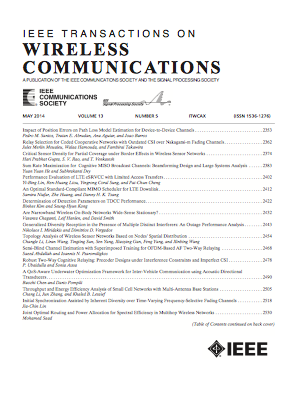Deep Learning-Based Channel Extrapolation for 5G Advanced Massive MIMO: Hardware Prototype and Experimental Evaluation
IF 10.7
1区 计算机科学
Q1 ENGINEERING, ELECTRICAL & ELECTRONIC
引用次数: 0
Abstract
In this paper, we study the deep learning (DL) based channel extrapolation problem and conduct the over-the-air (OTA) antenna extrapolation and frequency channel interpolation test for the 3rd generation partnership project (3GPP) long-term evolution (LTE) time-division duplex (TDD)-like orthogonal frequency division multiplexing (OFDM) massive MIMO prototype. We first present measurement campaigns using universal software radio peripherals (USRP) at 3.5 GHz, where the base station (BS) is composed of a 64-element antenna array. A DL-based antenna extrapolation network is then designed to approximate the inner deterministic function among antennas from the attained channel data within the “training” pilots. We present an antenna selection network (ASN) that can select a limited number of antennas for the best extrapolation, which outperforms the uniform antenna selection in terms of channel reconstruction and signal detection. We also design a deep residual neural network for channel interpolation. The performance of the extrapolated channel is evaluated in terms of normalized mean squared error (NMSE) in comparison to the measured channels on all antenna ports or the full pilot-aided channels in all OFDM subcarriers. Experimental results show that ASN can reduce an average of 87.5% antenna ports and maintain channel estimation NMSE by基于深度学习的5G先进大规模MIMO信道外推:硬件原型和实验评估
在本文中,我们研究了基于深度学习(DL)的信道外推问题,并对第三代合作伙伴计划(3GPP)长期演进(LTE)时分双工(TDD)正交频分复用(OFDM)大规模MIMO原型进行了空中(OTA)天线外推和频率信道内插测试。我们首先介绍了使用3.5 GHz通用软件无线电外设(USRP)的测量活动,其中基站(BS)由64单元天线阵列组成。然后设计了一个基于dl的天线外推网络,从“训练”飞行员获得的信道数据中近似天线之间的内部确定性函数。我们提出了一种天线选择网络(ASN),它可以选择有限数量的天线进行最佳外推,在信道重建和信号检测方面优于均匀天线选择。我们还设计了一个深度残差神经网络用于信道插值。用归一化均方误差(NMSE)来评估外推信道的性能,并与所有天线端口上的测量信道或所有OFDM子载波中的全导频辅助信道进行比较。实验结果表明,与3GPP信道估计协议相比,ASN平均减少87.5%的天线端口,信道估计NMSE保持在10^{-2}$。
本文章由计算机程序翻译,如有差异,请以英文原文为准。
求助全文
约1分钟内获得全文
求助全文
来源期刊
CiteScore
18.60
自引率
10.60%
发文量
708
审稿时长
5.6 months
期刊介绍:
The IEEE Transactions on Wireless Communications is a prestigious publication that showcases cutting-edge advancements in wireless communications. It welcomes both theoretical and practical contributions in various areas. The scope of the Transactions encompasses a wide range of topics, including modulation and coding, detection and estimation, propagation and channel characterization, and diversity techniques. The journal also emphasizes the physical and link layer communication aspects of network architectures and protocols.
The journal is open to papers on specific topics or non-traditional topics related to specific application areas. This includes simulation tools and methodologies, orthogonal frequency division multiplexing, MIMO systems, and wireless over optical technologies.
Overall, the IEEE Transactions on Wireless Communications serves as a platform for high-quality manuscripts that push the boundaries of wireless communications and contribute to advancements in the field.

 求助内容:
求助内容: 应助结果提醒方式:
应助结果提醒方式:


